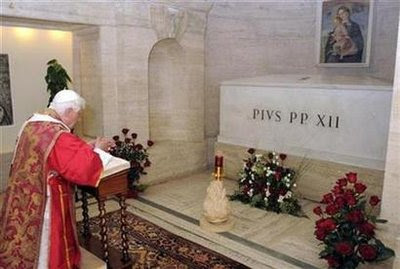 The Rite of Extreme Unction (1962):
The Rite of Extreme Unction (1962):
{The Constitution on the Sacred Liturgy says that, "in addition to the separate rites for anointing of the sick and for Viaticum a continuous rite will be prepared according to which the sick person is anointed after he has made his confession and before he receives Viaticum." And now--just before we go to press--the new "Instruction" of September 26, 1964, gives the rules for a continuous rite (see Rules for Administering Anointing of the Sick). Then at his discretion and depending on circumstances he may add prayers from the part dealing with the care of the sick, the apostolic blessing in the hour of death, and prayers for the dying. Although rubric no. 1 below does not require them, certainly it is proper to include among the appurtenances on the table a crucifix, two lighted candles, etc.}
1. As he is about to confer the sacrament of anointing of the sick the priest should see to it, if at all possible, that the following preparations are made. There should be in the sick-room a table covered with a white cloth; and on it a container with cotton or similar material made into six separate pellets for wiping the parts anointed, a small piece Of bread for cleansing the priest's fingers, and a bowl for washing his hands; a wax candle to be ignited later to give light to the priest as he performs the anointings In fine, it shall be his concern that everything is as clean and orderly as possible for the administration of this sacrament.
2. Then the clerics or servers are summoned, or at least one cleric to carry the cross (one without a staff, not the processional cross), holy water and aspersory, and the Ritual. The priest himself reverently takes the vessel containing the oil of the sick (encased in a silk cover of purple color), and bears it carefully so that it will not spill. If the journey is long or is to be made on horseback (sic!), or if there is any danger whatever of spilling the holy oil, the vessel enclosed in the sack or burse as already stated should be suspended from the neck so that it can be carried more easily and securely. No bells are rung in the course of the journey.
Introductory Prayers
The three introductory prayers that follow are very much the same as those ordinarily used for a priest's visit to the home of a sick person. They are preceded by the peace-greeting, the sacramental of sprinkling with holy water, which commonly is a reminder of baptism and an occasion for renewing the baptismal promises, confession if the person wishes to confess, and a little sermon in which the priest offers some consoling thoughts along with a summary of the nature and effects of the sacrament of the sick (see the introduction). If time permits the priest may choose to read one of the psalms and one or the other gospel passages taken from the rite of visitation and care of the sick.
3. Arriving at the place where the sick person is confined, the priest on entering the room says:
P: God's peace be in this home.
All: And in all who live here.
4. The priest places the holy oil on the table, and then vests in surplice and stole. Next he presents a crucifix to be devoutly kissed by the sick person. After that he sprinkles holy water in the form of a cross on the patient, the room, and the bystanders, saying:
Purify me with hyssop, Lord, and I shall be clean of sin. Wash me, and I shall be whiter than snow. Have mercy on me, God, in your great kindness. Glory be to the Father, and to the Son, and to the Holy Spirit.
All: As it was in the beginning, is now, and ever shall be, world without end. Amen.
P: Purify me with hyssop, Lord, and I shall be clean of sin. Wash me, and I shall be whiter than snow.
If the patient wishes to go to confession, he hears his confession and absolves him. Then he speaks words of consolation to him and if time permits briefly explains the power and efficacy of this sacrament. When advisable he adds words of encouragement and directs the patient's thoughts to hope of everlasting life.
5. Next he says:
P: Our help is in the name of the Lord. All: Who made heaven and earth. P: The Lord be with you. All: May He also be with you.
The plural form used in the next prayer is by no means the majestic plural but a relic of the days when a number of priests assisted. Now it can refer to those who assist the priest.
Let us pray.
Lord Jesus Christ, as we, in all humility, enter this home, let there enter with us abiding happiness and God's choicest blessings. Let serene joy pervade this home and charity abound here and health never fail. Let no evil spirits approach this place but drive them far away. Let your angels of peace take over and put down all wicked strife. Teach us, O Lord, to recognize the grandeur of your holy name. Sanctify our humble visit and bless  what we are about to do; you who are holy, you who are kind, you who abide with the Father and the Holy Spirit forever and ever.
what we are about to do; you who are holy, you who are kind, you who abide with the Father and the Holy Spirit forever and ever.
All: Amen.
Let us pray and beseech our Lord Jesus Christ to bless this dwelling more and more and all who live in it. May He give them an able guardian angel. May He prompt them to serve Him and to ponder the wonders of His law. May He ward off all diabolical powers from them, deliver them from all fear and anxiety, and keep them in good health in this dwelling; He who lives and reigns with the Father and the Holy Spirit, forever and ever.
All: Amen.
Let us pray.
Hear us, holy Lord Father, almighty everlasting God, and in your goodness send your holy angel from heaven to watch over and protect all who live in this home, to be with them and give them comfort and encouragement; through Christ our Lord.
All: Amen.
6. If time does not permit, all or part of the foregoing prayers may be omitted. Next comes as usual the general confession of sins (Confiteor), after which the priest says:
May almighty God have mercy on you, forgive you your sins, and lead you to everlasting life.
All: Amen.
P: May the almighty and merciful Lord grant you pardon, absolution,  and remission of your sins.
and remission of your sins.
All: Amen.
.jpg)
Invocation of the Trinity and Anointings
Rubric no. 7 directs the bystanders to recite the penitential psalms and Litany of the Saints while the priest is performing the anointings. This was well advised in former days when the prayers and forms were said in Latin. In our present practice it is surely preferable to have the people listen to the stately official prayers and make the responses as indicated.
7. Before the priest begins to anoint the sick person he invites all present to pray for him. And if circumstances are favorable and those present are able to do so
they should recite the seven penitential psalms and Litany of the Saints or other prayers while the priest administers the sacrament. First the priest extends his right hand over the head of the sick person, saying:
In the name of the Father, and of the Son, and of the Holy Spirit; may any power the devil has over you be destroyed by the laying-on of our hands and by calling on the glorious and blessed Virgin Mary, Mother of God, her illustrious spouse, St. Joseph, and all holy angels, archangels, patriarchs, prophets, apostles, martyrs, confessors, virgins, and all the saints.
All: Amen.
8. Next he dips his thumb in the holy oil, and anoints the sick person in the form of a cross on all bodily members indicated below, pronouncing in each instance the respective form as follows:*
* In the case of bodily members which are double, the right organ is anointed at the place indicated in the form by the, and the left organ before the remaining words are completed.--Trans.
Anointing the Eyes (on the eyelids)
By this holy anointing and by His most tender mercy may the Lord forgive you all the evil you have done through the power of sight.
All: Amen.
9. After every anointing the assistant, provided he is in holy orders, otherwise the priest himself, wipes the part anointed with a fresh pellet of cotton or similar material. These pellets are deposited in a clean receptacle and later taken to church where they are burned and the ashes thrown into the sacrarium.
Anointing the Ears (on the lobes)
By this holy anointing and by His most tender mercy may the Lord forgive you all the evil you have done through the power of hearing.
All: Amen.
Anointing the Nose (on each nostril)
By this holy anointing and by His most tender mercy may the Lord forgive you all the evil you have done through the sense of smell.
All: Amen.
Anointing the Mouth (on closed lips)
By this holy anointing and by His most tender mercy may the Lord forgive you all the evil you have done through the sense of taste and the power of speech.
All: Amen.
Anointing the Hands (on the palms)
By this holy anointing and by His most tender mercy may the Lord forgive you all the evil you have done through the sense of touch.
All: Amen.
10. Note as said above that priests are anointed on the back of the hands, not on the palms.
Anointing the Feet (either on the instep or sole)
By this holy anointing and by His most tender mercy may the Lord forgive you all the evil you have done through the ability to walk.
All: Amen.
11. The anointing of feet, as has been said, may be omitted for any good reason.
12. When the priest has finished the anointings he rubs his thumb with particles of bread, then washes his hands and wipes them with a towel. The water used for this purpose together with the bread is later thrown into the sacrarium, or for lack of such, into another decent receptacle. Afterward the priest says:
Lord, have mercy. Christ, have mercy. Lord, have mercy. Our Father (the rest inaudibly until:)
P: And lead us not into temptation. All: But deliver us from evil.
P: Save your servant.
All: Who trusts in you, my God.
P: Lord, send him (her) aid from your holy place.
All: And watch over him (her) from Sion.
P: Let him (her) find in you, Lord, a fortified tower.
All: In the face of the enemy.
P: Let the enemy have no power over him (her).
All: And the son of iniquity be powerless to harm him (her).
P: Lord, heed my prayer.
All: And let my cry be heard by you.
P: The Lord be with you.
All: May He also be with you.
Let us pray.
Lord God, who spoke through your apostle James, "Is anyone of you sick? He should call in the priests of the Church, and have them pray over him, while they anoint him with oil in the name of the Lord. That prayer, said with faith, will save the sick person, and the Lord will restore him to health. If he has committed sins, they will be forgiven him." We beg you, our Redeemer, to cure by the grace of the Holy Spirit this sick man's (woman's) infirmity. Heal his (her) wounds, and forgive his (her) sins. Rid him (her) of all pain of body and mind. Restore him (her), in your mercy, to full health of body and soul, so that having recovered by your goodness, he (she) may take up his (her) former duties. We ask this of you who live and reign with the Father and the Holy Spirit, God, forever and ever.
All: Amen.
Let us pray.
We entreat you, Lord, to look with favor on your servant, N., who is weak and failing, and refresh the life you have created. Chastened by suffering, may he (she) know that he (she) has been saved by your healing; through Christ our Lord.
All: Amen.
Let us pray.
Holy Lord, almighty Father, everlasting God, in pouring out the grace of your blessing on the bodies of the sick, you show your loving care for your creatures. And so now as we call on your holy name, come and free your servant from his (her) illness and restore him (her) to health; reach out your hand and raise him (her) up; strengthen him (her) by your might; protect him (her) by your power; and give him (her) back in all desired well-being to your holy Church; through Christ our Lord.
All: Amen.
13. Lastly, if the patient's condition allows, the priest may add a few well-chosen words, inspiring him to resist the temptations of the devil, and if death comes to expire peacefully in the Lord.
14. He should leave some holy water for the use of the sick person and also a crucifix, unless he has one, so that he may often gaze on it and devoutly kiss it and embrace it.
15. He should likewise instruct the family or the nurse to notify the pastor immediately if the sick person gets worse or approaches the last agony, so that the priest may be present to assist the dying and commend his soul to God. But if death is imminent the priest should say the prayers for the commendation of a departing soul before he leaves the house.
16. All that pertains to the care and visitation of the sick, the prayers for the dying, the commendation of a departing soul, and the burial rites are found below in their proper place.
For the above in Latin, please see Sancta Missa






 what we are about to do; you who are holy, you who are kind, you who abide with the Father and the Holy Spirit forever and ever.
what we are about to do; you who are holy, you who are kind, you who abide with the Father and the Holy Spirit forever and ever..jpg)


.jpg)
.jpg)
.jpg)
.jpg)
.jpg)
.jpg)
.jpg)
.jpg)
.jpg)
.jpg)
.jpg)
.jpg)
.jpg)
.jpg)

.jpg)
.jpg)
.jpg)
.jpg)
.jpg)
.jpg)
.jpg)
.jpg)
.jpg)

.jpg)
.jpg)
.jpg)
.jpg)
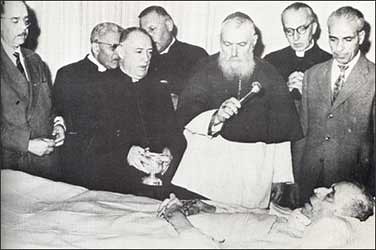
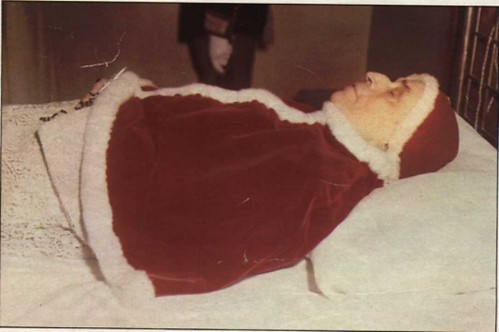
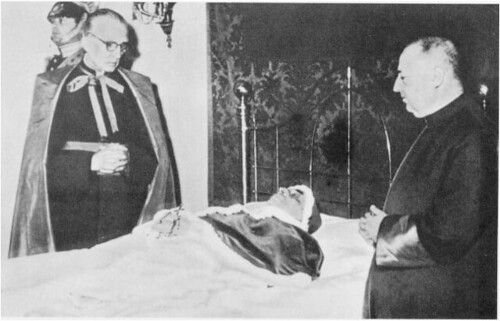
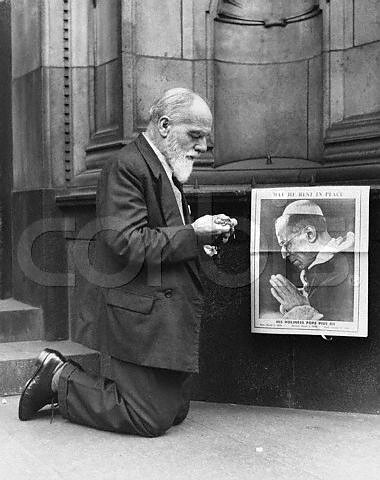
.jpg)
.jpg)
.jpg)
.jpg)
.jpg)
